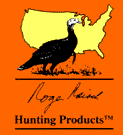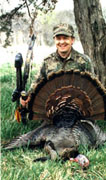Locating Flocks
Copyright © 1998 - 2021 Roger
W. Raisch * Nadine Adele, all rights reserved
|
An important SECRET
in fall hunting is knowing the current location, habits and sign left by turkey flocks. Pre-season and during-season scouting to locate birds is much more
important to the fall hunter than to a spring hunter. Almost any novice spring
hunter can locate gobblers by listening at dawn for gobbling activity in a good turkey
woods. A fall hunter, on the other hand, must generally
do a lot more work to locate birds.
|
During the summer
and fall, undisturbed turkey flocks will stay relatively close to food, fresh water,
pastures, open areas and adequate roosting trees. Where you
find a good mixture of these types of habitats you will usually locate birds.
Turkeys are nearby when you find fresh droppings, tracks or feathers.
|
The places to begin
your search are in and around the woods where you had luck in the spring. Check with local residents, landowners and other likely informants
about their sightings of fall flocks. Concentrate your search
close to food sources. Open woods, logging roads and
pastures, where grasshoppers and other insects are found, are excellent places to locate
turkey sign in early fall. Very little scratching will be found in the woods at
this time if there is a good supply of insects. After the insects are gone, and mast
is available, more scratching will be evident. Don't overlook standing grain fields
when looking for sign. Turkeys will feed around the edges of and through these
fields even though their vision may be somewhat impaired. If they lose sight of each
other, they will call often enough to be heard.
|
During late fall in colder
climates, grasshoppers and insects are dormant during cold early morning hours.
Therefore, the birds will spend increasing time in the timber scratching in the leaves for
acorns, seeds and other food. You may find turkeys coming back to open areas to feed
on insects during midday however, after the temperature has risen sufficiently for the
insects to become active again.
|
Loafing areas should
be located because birds will frequent these places routinely if undisturbed. These
are places where you may find a flock resting during midday.
Often dusting bowls are found close to loafing areas. You will find tracks and loose
body feathers in or by these dusting bowls. Almost any place may be a loafing area, but
certain spots have more appeal for a flock. In warmer weather, a shady spot is
preferred--under cedar trees, along creek banks or in low-lying, cool areas. When it
is colder, loafing areas are apt to be in protected, out-of-the-wind places, where the sun
can warm the birds.
|
Your chances for
success on any fall hunt can be improved if a flock's roosting location is known. For this reason, learning where fall
birds are likely to roost is the most important scouting that needs to be done. They will not roost in the same spot every day, but will probably
roost close to their current food source. Roosts will change as food is exhausted in
one spot and they move on to another location where food is available. You should
continue scouting during the hunting season because of this continuous movement of the
flocks. Turkeys like to roost in large trees with horizontal branches, which are
located on the sides of hills or toward the bottom of draws and ravines. This allows
them to fly directly off ridgetops to their roost trees with little effort. Look for
sign--droppings and feathers in these areas. The best sign is a concentration of droppings in various stages of
decomposition. This indicates a regular and current roost. |
| top ^ |
| |
t

God Bless America
|
View
Cart & Check-Out
NOVEMBER
2025
877.267.3877
515.299.5388
24 / 7
WE answer
our
phones Personally!
|
|












